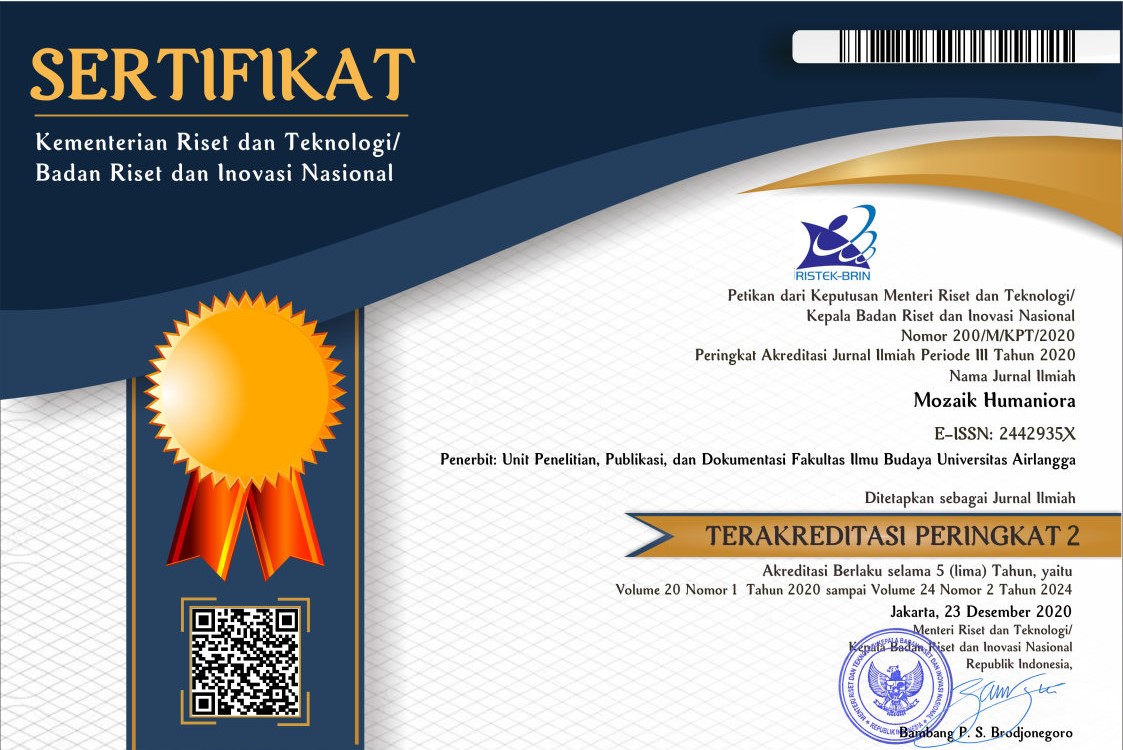Seluk-Beluk Prefiks Resiprokal ki- dalam Bahasa Loloda di Halmahera Utara Provinsi Maluku Utara
Downloads
Ariyanto. 1991. "Mengenali Verba Resiprokal Dalam Bahasa Indonesia” ("Identify Reciprocal Verb in Indonesian Language”). Jurnal Humaniora 2:1-30.
Bowden, Frederick John. 2014. "Verb of Excretion in Taba.” Linguistik Indonesia 32 (1):63-75.
Bussmann, Hudmod. 2006. Routledge Dictionary of Language and Linguistics, translated and edited by Gregory Trauth and Kerstin Kazzazi. London. Routledge 11 New Fetter Lane/Taylor & Francis e-Library.
Deda, A. J. & S.S. Mofu. 2014. "Masyarakat Hukum Adat dan Hak Ulayat di Propinsi Papua Barat sebagai Orang Asli Papua Ditinjau dari Sisi Adat dan Budaya: Sebuah Kajian Etnografi Kekinian.” Jurnal Administrasi Publik 11 (2):11-21.
Fernandes, I. Y. 1997. "Konstruksi Posesif Bahasa-bahasa Austronesia dan Non Austronesia di Kawasan Timur Indonesia: Studi Bandingan Bahasa Tetun (Timor Timur), Lamaholot (Flores Timur), dan Mai Brat (Kepala Burung).” Jurnal Humaniora V:31-37.
Gane, Maklon. 2017. "Meneropong Klausa dan Kalimat Bahasa Loloda.” Dalam Prosiding Seminar Nasional Annual Conference on Language and Tourism (ACOLISM). Sumedang.
Gane, Maklon., Wakit Abdullah, dan Dwi Purnanto. 2018. "Characteristics of Compound Words in Loloda Language.” Dalam Proceeding BASA: The 2nd International Seminar on Recent Language, Literature, and Local Cultural Study. Surakarta.
Ibrahim, M. Hi. 2017. "Fonologi Isolek Non-Austronesia di Pulau Morotai” ("The Phonology of Non-Austronesian Isolect in Morotai Island”). Gramatika V (1):75-89.
Kotynski, Edward A. 1995. "Glottal Stop And The Nasal Prefix in Tabaru and Other Halmaheran Languages.” edited by Wyn D. Laidig. SIL. Descriptive Studies in Languages of Maluku Part II. NUSA Linguistics Studies of Indonesian and Other Languages in Indonesia 38:1-17.
Kridalaksana, Harimurti. 1983. "On Reciprocity.” Majalah Linguistik Indonesia I (1):72-76.
________. 2007. Kelas Kata dalam Bahasa Indonesia. Jakarta: Gramedia Pustaka utama.
Litamahuputty, Betty. 2014. "Kata Dan Makna dalam Bahasa Melayu Ternate.” Linguistik Indonesia 32 (2):179-197.
Maturbongs, Antonius. 2015. "Peran Semantis Verba Bahasa Nafri” ("Semantic Role of the Nafri Language Verbs”). Metalingua 13 (2):125-140.
________. 2016. "Peran Semantis Verba Bahasa Abun” ("Semantic Role of the Verb of Abun Language”). Kandai 12 (1):17-37
Mashun. 2014. Metode Penelitian Bahasa: Tahapan Strategi, Metode, dan Tekniknya. Jakarta: Rajawali Pers.
Mukhamdanah. 2015. "Adaptasi Linguistik Pada Beberapa Bahasa di Pegunungan Arfak, Manokwari, Papua Barat” ("Linguistic Adaption in Several Languages in Arfak Mountains, Manokwari, West Papua”). Metalingua 13 (2):173-184.
Rahman, Abdullah. 2015. "Struktur Sosial Politik Kerajaan Loloda di Antara Minoritas Islam dan Mayoritas Kristen Abad ke-XVII-XX.” Al-Turas XXI (2):205-228.
Shelden, Howard. 1985. "Transitity and Galela Pronominal Refence.” Seminar for Research of Eastern Indonesia. Manado.
Subroto. H. D. E. 2013. Pemerian Morfologi Bahasa Indonesia: Berdasarkan Perspektif Derivasi dan Infleksi Proses Pemajemukan dan Perulangan. Yogyakarta: Media Perkasa.
Sugono, D., et al. 2008. Kamus Besar Bahasa Indonesia. Jakarta: Balai Pustaka Utama.
Watuseke, F. S. 1991. "The Ternate Language.” In Papers in Papuan Linguistics No.1, Pacific Linguistics, A-73. Canberra: Australian National University.
Winarti, S. 2017. "Sistem Bilangan Beberapa Bahasa di Papua, NTT, dan Maluku Utara” ("Numeral System of Several Languages in Papua, East Nusa Tenggara, and Northern Maluku”). Ranah: Jurnal Kajian Bahasa 6 (2):235-257.

Mozaik Humaniora is licensed under a Creative Commons Attribution-ShareAlike 4.0 International License. Both authors and Mozaik Humaniora agree with the following attribution of journal:
1. Copyright of this journal is possession of Author, by the knowledge of the Editorial Board and Journal Manager, while the moral right of the publication belongs to the author.
2. The journal allows the author(s) to retain publishing rights without restrictions
3. The legal formal aspect of journal publication accessibility refers to Creative Commons Attribution Share-Alike (CC BY-SA).
4. The Creative Commons Attribution Share-Alike (CC BY-SA) license allows re-distribution and re-use of a licensed work on the conditions that the creator is appropriately credited and that any derivative work is made available under "the same, similar or a compatible license”. Other than the conditions mentioned above, the editorial board is not responsible for copyright violation.


















